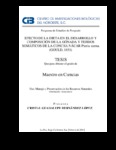| dc.description.abstracten | "Effect of diet on the development and composition of the gonad and somatic tissues of the winged pearl oyster Pteria sterna (Gould, 1851)"
In bivalve molluscs, the reproductive process is regulated by a complex interaction of abiotic and biotic factors, among which temperature and food availability play a key role. In the winged pearl oyster Pteria sterna , it is yet unknown the influence of the diet on development and composition of the gonad and somatic tissues involved in energy storage, as well as the effect of supplementing the algal diet with artificial feeds of different nutritional profile (mainly carbohydrates and lipids). A total of 132 organisms were collected from a submarine trestle in Bahia La Paz off the natural breeding season and were kept at a constant temperature of 23 ± 1 ° C with a continuous flow-through system. Estimations of food rations were based on the dry weight of soft tissues of individuals (DW). The experimental diets included: (A) a control group consisting of 100% of a diet prepared with the microalgae Isochrysis galbana, Pavlova salina and Chaetoceros calcitrans, at a 1:1:1 ratio and on the basis of 2% DW; (B and C) included the control diet supplemented with commercial corn starch at 1 and 2% DW, respectively; and (D and E) included the control diet supplemented with gelatin-acacia microcapsules (GAM) at 1 and 2% DW respectively, which were prepared from HUFA-rich commercial Omega-Mex DHA30® The size (0.1 mm) and weight (0.1 g) of organisms were determined at the beginning and end of the experiment, together with samples of the gonad, digestive gland, adductor muscle, and mantle. With the samples of the gonad and digestive gland we calculated an index of tissue coverage (ITG) and the remaining tissues were used for determining a condition index (CI) and muscle performance index (MPI). In turn, all tissue samples were used for histological (gonad development, sex ratio, oocyte size), histochemical (measurement of lipid and carbohydrate droplets within oocytes) and biochemical (concentration of protein, carbohydrate and lipid substrates) analyses. The variations in the CI and MPI were not significant between treatments. The presence of females was a low throughout the study and yielded values of ITG above 50% in all treatments, while the ITG was below 40% for males. Histochemical analysis showed there was a greater content of lipid droplets in the digestive gland (30 to 50%) than in other tissues, including the gonad. We also observed a greater accumulation of carbohydrate granules in the tissue (20 and 30%) in conjunctive tissue. The digestive gland accumulated more carbohydrates and lipids, the latter with a significant concentration in those oysters supplemented with 2% DW GAM. In contrast, the muscle had the highest protein concentration in the control group (> 670 mg/g-1). In the gonad there was a decrease in the carbohydrate concentration from baseline, achieving significantly higher levels in the treatment supplemented at 1 and 2% with corn starch. Protein levels remained above of 400 mg/g-1 in gonadic tissue, while lipid concentrations were higher compared to other tissues, particularly in the oysters supplemented at 1 and 2% with GAM. These results help to define the nutritional requirements of P. sterna under laboratory conditions. | es_MX |

